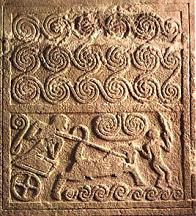
The beginning of meanders? An Egyptian pot with spirals (Naqada II, ca. 4000 BC)
What are meanders?
A meander is a kind of pattern that artists used to decorate the borders or edges of pictures. They’re called meanders because “meander” means to wander. So these are lines that wander around before they get anywhere. Some meander patterns are simple, and others are more complicated.
Egyptian pottery
Early African pottery
History of pottery
All our ancient Egypt articles

Kerma, Sudan, ca. 1700 BC (now in Boston MFA)
African running spirals
The very beginnings of meanders may be painted spirals. We see painted spirals on Stone Age Egyptian pottery from about 4000 BC. These spirals might represent water – waves? – but it’s hard to say. By about 1700 BC, artists in Sudan, further south, were connecting those spirals in a running spiral pattern.
Stone Age Egypt
Bronze Age Sudan
Early African art

Running spirals on a Bronze Age Greek gravestone (Grave Circle A, Mycenae, 1500s BC)
Running spirals in Greece
Those running spirals were popular. They soon spread from Sudan to Egypt, and from there to Greece. To the Greeks (and maybe also to the people of Sudan and Egypt), these spirals probably represented the afterlife. That is why you see running spirals on gravestones and on clay pots used as grave markers.
The Greek afterlife
Bronze Age Greek pottery

Lie-wen or Thunder Cloud pattern (Shang Dynasty, ca. 1200 BC)
Chinese lei-wen pattern
There’s a similar pattern on many bronze jars from the Chinese Shang Dynasty. We call this pattern the “thunder cloud” or lei-wen. It appears first in the 2000s BC. In China, the pattern represented rain and good harvests, and the jars were – again – put in people’s graves. Nobody knows whether these patterns are related.
China’s Shang Dynasty
Shang Dynasty art
More China articles

Meanders on a Greek geometric vase, 800s BC (now in the British Museum)
Meanders on Greek pottery
The earliest examples of real meanders are on Greek vase paintings from the Geometric period, in the 800s BC. Meanders quickly became very common on Greek vases, all the way through the Geometric and into black figure vases.
Greek geometric pottery

Roman meanders: The carved frieze on the Ara Pacis shows Augustus and his household going to perform a traditional religious sacrifice.
Meanders in ancient Rome
You can see another complicated meander pattern carved into the Ara Pacis, the Altar of Peace, in Rome. The emperor Augustus built the Ara Pacis about 30 BC.
More about the Ara Pacis
This was right after the Romans had conquered Greece. Roman artists wanted to show that they were cool and could use Greek art ideas, but in their own way. But with the rise of Christianity, meanders fell out of use in Roman and medieval art. Maybe they seemed too much like reminders of the traditional afterlife. In China, artists kept on using meanders.





mmmmmmmmmm nice work you guys did
Thank you Lateefah!